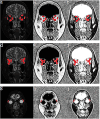Dixon MRI-based quantitative parameters of extraocular muscles, intraorbital fat, and lacrimal glands for staging thyroid-associated ophthalmopathy
- PMID: 38853188
- PMCID: PMC11162983
- DOI: 10.1186/s13244-024-01693-w
Dixon MRI-based quantitative parameters of extraocular muscles, intraorbital fat, and lacrimal glands for staging thyroid-associated ophthalmopathy
Abstract
Objective: To investigate the value of Dixon magnetic resonance imaging (MRI)-based quantitative parameters of extraocular muscles (EOMs), intraorbital fat (IF), and lacrimal glands (LGs) in staging patients with thyroid-associated ophthalmopathy (TAO).
Methods: Two hundred patients with TAO (211 active and 189 inactive eyes) who underwent Dixon MRI for pretreatment evaluation were retrospectively enrolled and divided into training (169 active and 151 inactive eyes) and validation (42 active and 38 inactive eyes) cohorts. The maximum, mean, and minimum values of the signal intensity ratio (SIR), fat fraction (FF), and water fraction (WF) of EOMs, IF, and LGs were measured and compared between the active and inactive groups in the training cohort. Binary logistic regression analysis, receiver operating characteristic curve analysis, and the Delong test were used for further statistical analyses, as appropriate.
Results: Compared with inactive TAOs, active TAOs demonstrated significantly greater EOM-SIRmax, EOM-SIRmean, EOM-SIRmin, IF-SIRmax, IF-SIRmean, LG-SIRmax, LG-SIRmean, EOM-WFmean, EOM-WFmin, IF-WFmax, IF-WFmean, and LG-WFmean and lower EOM-FFmax, EOM-FFmean, IF-FFmean, IF-FFmin, and LG-FFmean values (all p < 0.05). The EOM-SIRmean, LG-SIRmean, and LG-FFmean values were independently associated with active TAO (all p < 0.05). The combination of the EOM-SIRmean, LG-SIRmean, and LG-FFmean values showed better performance than the EOM-SIRmean value alone in staging TAO in both the training (AUC, 0.820 vs 0.793; p = 0.016) and validation (AUC, 0.751 vs 0.733, p = 0.341) cohorts.
Conclusion: Dixon MRI-based parameters of EOMs, LGs, and IF are useful for differentiating active from inactive TAO. The integration of multiple parameters can further improve staging performance.
Critical relevance statement: In this study, the authors explored the combined value of quantitative parameters of EOMs, IF, and LGs derived from Dixon MRI in staging TAO patients, which can support the establishment of a proper therapeutic plan.
Key points: The quantitative parameters of EOMs, LGs, and IF are useful for staging TAO. The EOM-SIRmean, LG-SIRmean, and LG-FFmean values were found to independently correlate with active TAO. Joint evaluation of orbital tissue improved the ability to assess TAO activity.
Keywords: Dixon magnetic resonance imaging; Extraocular muscle; Intraorbital fat; Lacrimal gland; Thyroid-associated ophthalmopathy.
© 2024. The Author(s).
Conflict of interest statement
The authors declare no competing interests.
Figures




Similar articles
-
Usefulness of two-point Dixon T2-weighted imaging in thyroid-associated ophthalmopathy: comparison with conventional fat saturation imaging in fat suppression quality and staging performance.Br J Radiol. 2021 Feb 1;94(1118):20200884. doi: 10.1259/bjr.20200884. Epub 2020 Dec 22. Br J Radiol. 2021. PMID: 33353397 Free PMC article.
-
Predicting the response to glucocorticoid therapy in thyroid-associated ophthalmopathy: mobilizing structural MRI-based quantitative measurements of orbital tissues.Endocrine. 2020 Nov;70(2):372-379. doi: 10.1007/s12020-020-02367-5. Epub 2020 Jun 5. Endocrine. 2020. PMID: 32504380
-
Image quality and evaluation ability of magnetic resonance imaging techniques for thyroid-associated ophthalmopathy: Dixon fat-suppression technique vs. spectral attenuated inversion recovery.Front Med (Lausanne). 2023 Jul 12;10:1154828. doi: 10.3389/fmed.2023.1154828. eCollection 2023. Front Med (Lausanne). 2023. PMID: 37502355 Free PMC article.
-
The Value of MRI and Radiomics for the Diagnostic Evaluation of Thyroid-Associated Ophthalmopathy.Diagnostics (Basel). 2025 Feb 6;15(3):388. doi: 10.3390/diagnostics15030388. Diagnostics (Basel). 2025. PMID: 39941318 Free PMC article. Review.
-
Extra-ocular muscle cells from patients with Graves' ophthalmopathy secrete α (CXCL10) and β (CCL2) chemokines under the influence of cytokines that are modulated by PPARγ.Autoimmun Rev. 2014 Nov;13(11):1160-6. doi: 10.1016/j.autrev.2014.08.025. Epub 2014 Aug 27. Autoimmun Rev. 2014. PMID: 25172242 Review.
Cited by
-
Application progress of magnetic resonance imaging in thyroid associated ophthalmopathy.Front Endocrinol (Lausanne). 2025 Jun 26;16:1537957. doi: 10.3389/fendo.2025.1537957. eCollection 2025. Front Endocrinol (Lausanne). 2025. PMID: 40642513 Free PMC article. Review.
-
The diagnostic performance comparison between T2 mapping and Dixon against the activity of thyroid-associated ophthalmopathy: a systematic review and meta-analysis.Front Endocrinol (Lausanne). 2024 Dec 12;15:1502296. doi: 10.3389/fendo.2024.1502296. eCollection 2024. Front Endocrinol (Lausanne). 2024. PMID: 39726842 Free PMC article.
References
Grants and funding
- JSPH-MC-2021-8/Jiangsu Province Hospital (the First Affiliated Hospital with Nanjing Medical University) Clinical Capacity Enhancement Project
- JSPH-MC-2021-8/Jiangsu Province Hospital (the First Affiliated Hospital with Nanjing Medical University) Clinical Capacity Enhancement Project
- JSPH-MC-2021-8/Jiangsu Province Hospital (the First Affiliated Hospital with Nanjing Medical University) Clinical Capacity Enhancement Project
LinkOut - more resources
Full Text Sources
Miscellaneous

